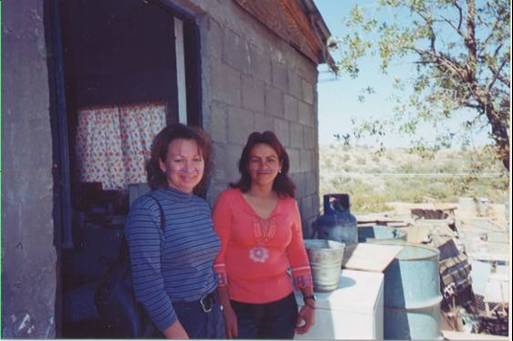


BorderLink to a Broader Think
On the Borderlinks fieldtrip to Nogales, Mexico, I experienced a world that I could only imagine from my migration readings. The environment of the maquiladoras and the women affected by them became dramatically real when I saw that the people behind the stories actually existed. I expected the trip to be interesting, but to personally see the modern industrial age situated in the middle of underdeveloped surroundings was alarming. I am sure, people of the United States do not fully understand this third world existence right across our border.
The manufacturing facility that we visited was reminiscent of the factory floor of Honeywell Industrial Automation and Control in Phoenix, where I spent years walking among the "line workers" on my clerical rounds. Realistically, I know that the factory version of the Maquiladora that I saw on the fieldtrip was a facade for the harsher sweatshops lurking in the background of Nogales, Mexico. I suspect this was the case, because some of the information presented by the "tour guide" seemed fictitious. The lunchroom for instance, that served "hot lunches" daily was too sterile to be a working cafeteria, there were no lingering smells or lunch supplies. The guide was the son of the owner or perhaps the manager; he was missing the tips of his fingers on his left hand. This resembled a wound consistent with that of an industrial accident. If this is the case, and the son bears such scars, I can only imagine the state of the "real" worker’s anatomy. I could not help but contemplate the women of the maquiladoras that are forced to endure sexual harassment, dreadful working conditions and degrading pregnancy checks, such as I had read about. I wondered if the "medical attention" they receive as a monthly "benefit" includes forced abortions if they wish to maintain their employment.
These speculations are admittedly the meanderings of a naive and suspicious mind, but I can not believe that a business that traditionally exploits employees would miraculously become a pillar of business humanity in a city that has 300,000 people with few resources and small voices.
I was impressed by the small but important voice of Cecilia, a Mexican staff member of Borderlinks. She told us of her experience as an activist. She helped the poorest of children and spoke for those that are otherwise not heard. She mentioned the women of Juarez and the terrible cases of local maquiladora women found decapitated in similar situations. When asked about the police response, she said, "We fear drug traffickers and the authorities, because it is hard to know who is worse." This is a powerful statement that gets directly to the heart of the difficulties of life in a border town like Nogales, Mexico. If her own Mexican people can not or will not help, certainly a bully like the United States will not either, unless politically forced to do so.
The following week, I attended the candlelight vigil on the ASU West campus for the Juarez women. It was a touching event, especially now that I can see the women as real people. The wind gently moved the 300 dresses that were hung on thin pink crosses as memorials those killed in Juarez. As night fell, we lit our candles and made our way through the make shift cemetery. The names and ages of the deceased women, if known, were read as we wandered with our eternal flames. It was a touching tribute and I hope an effective one for those who are actively pursuing a change in policy and justice for the Juarez maquiladora women.
Return to T. Vogt's Home Page
Return to Migration Home Page